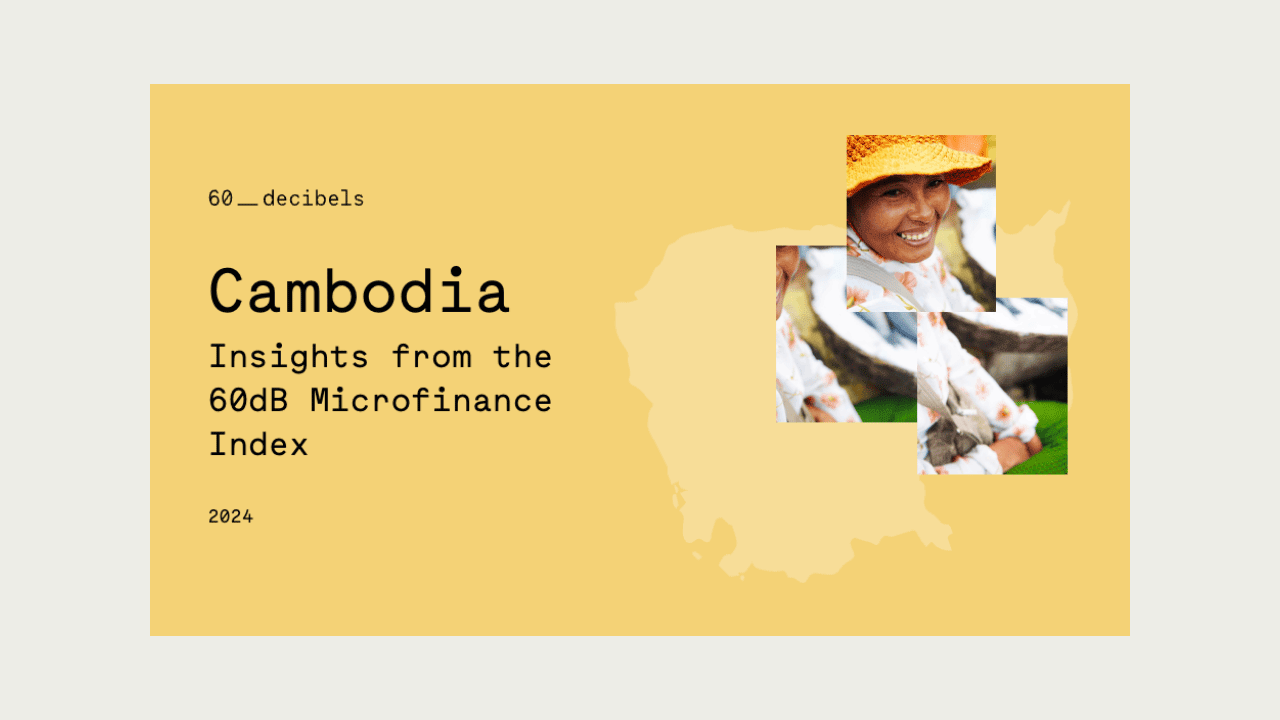
Cambodia Microfinance Report
Our Cambodia Microfinance Report is based on telephone interviews with 2,939 Cambodian microfinance clients in 2023. We employed a random sampling methodology to select respondents from 10 Financial Service Providers (FSPs).
To provide context for the findings specific to Cambodia, this report includes regional comparisons to the rest of Asia (excluding Cambodia) and global benchmarks.
“The sample of nearly 3000 borrowers of 10 Cambodian FSPs is a really clear picture of the sector, and the clients didn’t hold back on what they had to say.”
Daniel Rozas – Senior Microfinance Expert, e-MFP
2,939
10
64%
Comparative performance of Cambodian FSPs vs. FSPs in the Rest of Asia across 18 indicators including client protection, household impact, business impact, access, resilience, and agency. A sample of the data included is listed below:
Data Bank
-
Access
First Access
% of clients who are accessing a loan like the one from their FSP for the first time
Access to Alternatives
% of clients who could not easily find a good alternative to their FSP
-
Business Impact
Income Change
% of clients who say their income has ‘very much increased’
Employment
% of clients who say their employees have increased
-
Household Impact
Quality of Life
% of clients who say their quality of life has ‘very much improved’
Education Spending
% of clients who say their spending on child’s education has ‘very much increased’
Healthcare
% of clients who say their ability to visit a healthcare provider ‘very much increased’
Number and Quality of Meals
% of clients who say their households number and quality of meals ‘very much increased’
-
Client Protection
Loan Understanding
% of clients who say they strongly agree with their fees, interest rates, and penalties
Worry About Finances
% of clients who say their worry about finances has ‘very much decreased’
Repayment Burden
% of clients who say their loan repayments are ‘not a burden’
Reduced Consumption
% of clients who have never reduced their households’ food consumption in order to make a repayment
-
Resilience
Financial Management
% of clients who their ability to manage finances has ‘very much improved’
Savings
% of clients who savings have ‘very much increased’
Financial Resilience Attribution
% of clients who their ability to manage finances has ‘very much improved’
-
Agency
Confidence
% of clients who say their confidence has ‘very much increased’
Decision Making
% of clients who say their decision-making ability has ‘very much increased’
Ability to Achieve Financial Goal
% of clients who say their ability to achieve their financial goals has ‘very much increased’
Information Included in the Report
-
Cambodian Microfinance Context
In this section, we deep dive into our data from Cambodian clients and share interesting trends and insights from our findings compared to other data sources to tackle a central unanswered question: Is Cambodian microfinance hurting people more than it’s helping them?
-
Insights
The key questions answered throughout this section are:
- Is the repayment burden too high for Cambodian clients?
- How well do Cambodian clients understand their loans & do they cause worry?
- What is the impact of microfinance on households and businesses in Cambodia?
- Is microfinance reaching the poorest, most rural populations in Cambodia?
- To invest in Cambodian Financial Services Providers or not?
-
About our Data
We worked with 10 Financial Service Providers and interviewed 2,939 clients in Cambodia. It is estimated in Cambodia that 1 in 4 Cambodians are microfinance clients. Our data from Cambodia is not comprehensive and representative of the Cambodian market. This section provides an overview on the clients and FSPs that participated in the 60 Decibels Microfinance Index.
-
What’s Next?
There are some stark differences in our data of Cambodian clients and the clients in the rest of Asia. The data in this report paint a picture of a market that is struggling to balance the well-being of clients with institutional growth. To support the ongoing improvement of results for Cambodian clients, we need ongoing, comprehensive data that track the evolution of outcomes from clients’ perspectives.